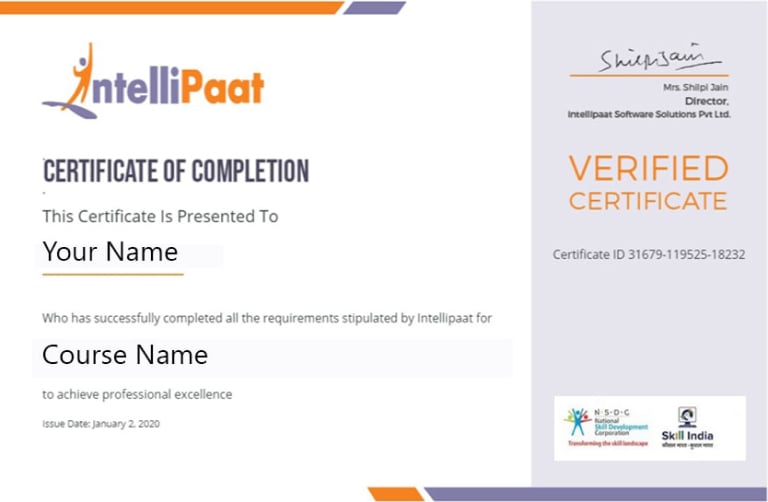Your cart is currently empty.
Become a Big Data Certified Developer with our Big Data Course in just 3 months!

Watch
Course PreviewRead More
There are no prerequisites to taking this big data course and mastering the technology. But the basics of UNIX, SQL, and Java would be good to learn big data Hadoop. At Intellipaat, we provide complimentary Linux and Java training with our big data certification course to brush up on those skills.
There are many different career paths in Big Data, each with unique skills and responsibilities. Some of the most common Big Data career paths include:
| Career Path | Description | Key Skills |
| Data Analyst | Collects, cleans, and analyzes data to identify trends and patterns. | SQL, Python, R, and data visualization tools |
| Data Engineer | Builds and maintains the infrastructure that stores and processes big data. | Hadoop, Spark, NoSQL databases, cloud computing |
| Data Scientist | Develops and applies machine learning algorithms to extract insights from data. | Python, R, machine learning libraries, statistics |
| Machine Learning Engineer | Builds and deploys machine learning models into production. | Python, R, machine learning libraries, and cloud computing |
| Big Data Architect | Designs and oversees the implementation of big data solutions. | Hadoop, Spark, NoSQL databases, cloud computing, data modeling |
| Business Intelligence Analyst | Helps businesses make better decisions by using data analysis and visualization. | SQL, Python, R, and data visualization tools |
| Data Visualization Specialist | Creates interactive data visualizations to help people understand data. | Python, R, and data visualization tools |
| Data Quality Engineer | Ensures the quality of data by developing and implementing data quality checks. | SQL and data profiling tools |
| Data Ethics Engineer | Identifies and mitigates ethical risks associated with big data. | Data ethics, privacy, and security |
Talk To Us
We are happy to help you 24/7
Spark
Scala
Sqoop
Pig
Apache Flume
Hive
HCatalog
AVRO
Scala REPL
SBT/Eclipse
Apache Kafka
Spark Streaming
Impala
₹20,007
Contact Us
1.1 The architecture of Hadoop Cluster
1.2 What is High Availability and Federation?
1.3 How to set up a production cluster?
1.4 Various shell commands in Hadoop
1.5 Understanding configuration files in Hadoop
1.6 Installing a single node cluster with Cloudera Manager
1.7 Understanding Spark, Scala, Sqoop, Pig, and Flume
2.1 Introducing Big Data and Hadoop
2.2 What is Big Data and where does Hadoop fit in?
2.3 Two important Hadoop ecosystem components, namely, MapReduce and HDFS
2.4 In-depth Hadoop Distributed File System – Replications, Block Size, Secondary Name node, High Availability and in-depth YARN – resource manager and node manager
Hands-on Exercise:
1. HDFS working mechanism
2. Data replication process
3. How to determine the size of the block?
4. Understanding a data node and name node
3.1 Learning the working mechanism of MapReduce
3.2 Understanding the mapping and reducing stages in MR
3.3 Various terminologies in MR like Input Format, Output Format, Partitioners, Combiners, Shuffle, and Sort
Hands-on Exercise:
1. How to write a WordCount program in MapReduce?
2. How to write a Custom Partitioner?
3. What is a MapReduce Combiner?
4. How to run a job in a local job runner
5. Deploying a unit test
6. What is a map side join and reduce side join?
7. What is a tool runner?
8. How to use counters, dataset joining with the map side, and reduce side joins?
4.1 Introducing Hadoop Hive
4.2 Detailed architecture of Hive
4.3 Comparing Hive with Pig and RDBMS
4.4 Working with Hive Query Language
4.5 Creation of a database, table, group by and other clauses
4.6 Various types of Hive tables, HCatalog
4.7 Storing the Hive Results, Hive partitioning, and Buckets
Hands-on Exercise:
1. Database creation in Hive
2. Dropping a database
3. Hive table creation
4. How to change the database?
5. Data loading
6. Dropping and altering table
7. Pulling data by writing Hive queries with filter conditions
8. Table partitioning in Hive
9. What is a group by clause?
5.1 Indexing in Hive
5.2 The Map Side Join in Hive
5.3 Working with complex data types
5.4 The Hive user-defined functions
5.5 Introduction to Impala
5.6 Comparing Hive with Impala
5.7 The detailed architecture of Impala
Hands-on Exercise:
1. How to work with Hive queries?
2. The process of joining the table and writing indexes
3. External table and sequence table deployment
4. Data storage in a different table
6.1 Apache Pig introduction and its various features
6.2 Various data types and schema in Hive
6.3 The available functions in Pig, Hive Bags, Tuples, and Fields
Hands-on Exercise:
1. Working with Pig in MapReduce and local mode
2. Loading of data
3. Limiting data to 4 rows
4. Storing the data into files and working with Group By, Filter By, Distinct, Cross, Split in Hive
7.1 Apache Sqoop introduction
7.2 Importing and exporting data
7.3 Performance improvement with Sqoop
7.4 Sqoop limitations
7.5 Introduction to Flume and understanding the architecture of Flume
7.6 What are HBase and the CAP theorem?
Hands-on Exercise:
1. Working with Flume to generate Sequence Number and consume it
2. Using the Flume Agent to consume the Twitter data
3. Using AVRO to create Hive Table
4. AVRO with Pig
5. Creating Table in HBase
6. Deploying Disable, Scan, and Enable Table
8.1 Using Scala for writing Apache Spark applications
8.2 Detailed study of Scala
8.3 The need for Scala
8.4 The concept of object-oriented programming
8.5 Executing the Scala code
8.6 Various classes in Scala like getters, setters, constructors, abstract, extending objects, overriding methods
8.7 The Java and Scala interoperability
8.8 The concept of functional programming and anonymous functions
8.9 Bobsrockets package and comparing the mutable and immutable collections
8.10 Scala REPL, Lazy Values, Control Structures in Scala, Directed Acyclic Graph (DAG), first Spark application using SBT/Eclipse, Spark Web UI, Spark in Hadoop ecosystem.
Hands-on Exercise:
1. Writing Spark application using Scala
2. Understanding the robustness of Scala for Spark real-time analytics operation
9.1 Introduction to Scala packages and imports
9.2 The selective imports
9.3 The Scala test classes
9.4 Introduction to JUnit test class
9.5 JUnit interface via JUnit 3 suite for Scala test
9.6 Packaging of Scala applications in the directory structure
9.7 Examples of Spark Split and Spark Scala
10.1 Introduction to Spark
10.2 Spark overcomes the drawbacks of working on MapReduce
10.3 Understanding in-memory MapReduce
10.4 Interactive operations on MapReduce
10.5 Spark stack, fine vs. coarse-grained update, Spark stack, Spark Hadoop YARN, HDFS Revision, and YARN Revision
10.6 The overview of Spark and how it is better than Hadoop
10.7 Deploying Spark without Hadoop
10.8 Spark history server and Cloudera distribution
11.1 Spark installation guide
11.2 Spark configuration
11.3 Memory management
11.4 Executor memory vs. driver memory
11.5 Working with Spark Shell
11.6 The concept of Resilient Distributed Datasets (RDD)
11.7 Learning to do functional programming in Spark
11.8 The architecture of Spark
12.1 Spark RDD
12.2 Creating RDDs
12.3 RDD partitioning
12.4 Operations and transformation in RDD
12.5 Deep dive into Spark RDDs
12.6 The RDD general operations
12.7 Read-only partitioned collection of records
12.8 Using the concept of RDD for faster and efficient data processing
12.9 RDD action for the collect, count, collects map, save-as-text-files, and pair RDD functions
13.1 Understanding the concept of key-value pair in RDDs
13.2 Learning how Spark makes MapReduce operations faster
13.3 Various operations of RDD
13.4 MapReduce interactive operations
13.5 Fine and coarse-grained update
13.6 Spark stack
14.1 Comparing the Spark applications with Spark Shell
14.2 Creating a Spark application using Scala or Java
14.3 Deploying a Spark application
14.4 Scala built application
14.5 Creation of the mutable list, set and set operations, list, tuple, and concatenating list
14.6 Creating an application using SBT
14.7 Deploying an application using Maven
14.8 The web user interface of Spark application
14.9 A real-world example of Spark
14.10 Configuring of Spark
15.1 Working towards the solution of the Hadoop project solution
15.2 Its problem statements and the possible solution outcomes
15.3 Preparing for the Cloudera certifications
15.4 Points to focus on scoring the highest marks
15.5 Tips for cracking Hadoop interview questions
Hands-on Exercise:
1. The project of a real-world high value big data Hadoop application
2. Getting the right solution based on the criteria set by the Intellipaat team
16.1 Learning about Spark parallel processing
16.2 Deploying on a cluster
16.3 Introduction to Spark partitions
16.4 File-based partitioning of RDDs
16.5 Understanding of HDFS and data locality
16.6 Mastering the technique of parallel operations
16.7 Comparing repartition and coalesce
16.8 RDD actions
17.1 The execution flow in Spark
17.2 Understanding the RDD persistence overview
17.3 Spark execution flow, and Spark terminology
17.4 Distribution shared memory vs. RDD
17.5 RDD limitations
17.6 Spark shell arguments
17.7 Distributed persistence
17.8 RDD lineage
17.9 Key-value pair for sorting implicit conversions like CountByKey, ReduceByKey, SortByKey, and AggregateByKey
18.1 Introduction to Machine Learning
18.2 Types of Machine Learning
18.3 Introduction to MLlib
18.4 Various ML algorithms supported by MLlib
18.5 Linear regression, logistic regression, decision tree, random forest, and K-means clustering techniques
Hands-on Exercise:
1. Building a Recommendation Engine
19.1 Why Kafka and what is Kafka?
19.2 Kafka architecture
19.3 Kafka workflow
19.4 Configuring Kafka cluster
19.5 Operations
19.6 Kafka monitoring tools
19.7 Integrating Apache Flume and Apache Kafka
Hands-on Exercise:
1. Configuring Single Node Single Broker Cluster
2. Configuring Single Node Multi Broker Cluster
3. Producing and consuming messages
4. Integrating Apache Flume and Apache Kafka
20.1 Introduction to Spark Streaming
20.2 Features of Spark Streaming
20.3 Spark Streaming workflow
20.4 Initializing StreamingContext, discretized Streams (DStreams), input DStreams and Receivers
20.5 Transformations on DStreams, output operations on DStreams, windowed operators and why it is useful
20.6 Important windowed operators and stateful operators
Hands-on Exercise:
1. Twitter Sentiment analysis
2. Streaming using Netcat server
3. Kafka–Spark streaming
4. Spark–Flume streaming
21.1 Introduction to various variables in Spark like shared variables and broadcast variables
21.2 Learning about accumulators
21.3 The common performance issues
21.4 Troubleshooting the performance problems
22.1 Learning about Spark SQL
22.2 The context of SQL in Spark for providing structured data processing
22.3 JSON support in Spark SQL
22.4 Working with XML data
22.5 Parquet files
22.6 Creating Hive context
22.7 Writing data frame to Hive
22.8 Reading JDBC files
22.9 Understanding the data frames in Spark
22.10 Creating Data Frames
22.11 Manual inferring of schema
22.12 Working with CSV files
22.13 Reading JDBC tables
22.14 Data frame to JDBC
22.15 User-defined functions in Spark SQL
22.16 Shared variables and accumulators
22.17 Learning to query and transform data in data frames
22.18 Data frame provides the benefit of both Spark RDD and Spark SQL
22.19 Deploying Hive on Spark as the execution engine
23.1 Learning about the scheduling and partitioning in Spark
23.2 Hash partition
23.3 Range partition
23.4 Scheduling within and around applications
23.5 Static partitioning, dynamic sharing, and fair scheduling
23.6 Map partition with index, the Zip, and GroupByKey
23.7 Spark master high availability, standby masters with ZooKeeper, single-node recovery with the local file system and high order functions
24.1 Create a 4-node Hadoop cluster setup
24.2 Running the MapReduce Jobs on the Hadoop cluster
24.3 Successfully running the MapReduce code
24.4 Working with the Cloudera Manager setup
Hands-on Exercise:
1. The method to build a multi-node Hadoop cluster using an Amazon EC2 instance
2. Working with the Cloudera Manager
25.1 Overview of Hadoop configuration
25.2 The importance of Hadoop configuration file
25.3 The various parameters and values of configuration
25.4 The HDFS parameters and MapReduce parameters
25.5 Setting up the Hadoop environment
25.6 The Include and Exclude configuration files
25.7 The administration and maintenance of name node, data node directory structures, and files
25.8 What is a File system image?
25.9 Understanding Edit log
Hands-on Exercise:
1. The process of performance tuning in MapReduce
26.1 Introduction to the checkpoint procedure, name node failure
26.2 How to ensure the recovery procedure, Safe Mode, Metadata and Data backup, various potential problems and solutions, what to look for and how to add and remove nodes
Hands-on Exercise:
1. How to go about ensuring the MapReduce File System Recovery for different scenarios
2. JMX monitoring of the Hadoop cluster
3. How to use the logs and stack traces for monitoring and troubleshooting
4. Using the Job Scheduler for scheduling jobs in the same cluster
5. Getting the MapReduce job submission flow
6. FIFO schedule
7. Getting to know the Fair Scheduler and its configuration
27.1 How do ETL tools work in the big data industry?
27.2 Introduction to ETL and data warehousing
27.3 Working with prominent use cases of big data in the ETL industry
27.4 End-to-end ETL PoC showing big data integration with ETL tool
Hands-on Exercise:
1. Connecting to HDFS from ETL tool
2. Moving data from the local system to HDFS
3. Moving data from DBMS to HDFS,
4. Working with Hive with ETL Tool
5. Creating MapReduce job in ETL tool
28.1 Importance of testing
28.2 Unit testing, Integration testing, Performance testing, Diagnostics, Nightly QA test, Benchmark and end-to-end tests, Functional testing, Release certification testing, Security testing, Scalability testing, Commissioning and Decommissioning of data nodes testing, Reliability testing, and Release testing
29.1 Understanding the Requirement
29.2 Preparation of the Testing Estimation
29.3 Test Cases, Test Data, Test Bed Creation, Test Execution, Defect Reporting, Defect Retest, Daily Status report delivery, Test completion, ETL testing at every stage (HDFS, Hive and HBase) while loading the input (logs, files, records, etc.) using Sqoop/Flume which includes but not limited to data verification, Reconciliation, User Authorization and Authentication testing (Groups, Users, Privileges, etc.), reporting defects to the development team or manager and driving them to closure
29.4 Consolidating all the defects and create defect reports
29.5 Validating new feature and issues in Core Hadoop
30.1 Report defects to the development team or manager and driving them to closure
30.2 Consolidate all the defects and create defect reports
30.3 Responsible for creating a testing framework called MRUnit for testing of MapReduce programs
31.1 Automation testing using the OOZIE
31.2 Data validation using the query surge tool
32.1 Test plan for HDFS upgrade
32.2 Test automation and result
33.1 Test, install and configure
Big Data Projects
This big data training is designed to help you clear the CCA175 Certification exams. The entire course content of this big data program is in line with these certification programs and helps you clear these exams with ease and get the best jobs in the top MNCs.
As part of this big data Hadoop course, you will be working on real-time projects and assignments that have immense implications in the real-world industry scenarios, thus helping you fast-track your career effortlessly.
At the end of this big data course, there will be quizzes that perfectly reflect the type of questions asked in the respective big data Hadoop certification exams and help you score better.
The Intellipaat Completion Certificate will be awarded upon the completion of the project work (after expert review) and upon scoring at least 60% on the quiz. Intellipaat certification is well recognized in the top 80+ MNCs like Ericsson, Cisco, Cognizant, Sony, Mu Sigma, Saint-Gobain, Standard Chartered, TCS, Genpact, Hexaware, etc.
Land Your Dream Job Like Our Alumni

It is a known fact that the demand for big data professionals in this domain far outstrips the supply. So, if you want to learn and make a career in the domain, then you need to enroll for Intellipaat Hadoop training which is the most recognized name in the Hadoop course and certification. Intellipaat’s big data course includes all major components of big data like Apache Spark, MapReduce, HBase, HDFS, Pig, Sqoop, Flume, Oozie and more. This entire Intellipaat big data training has been created by industry professionals. You will get 24/7 lifetime support, high-quality course material and videos and a free upgrade to the latest version of training material. Thus, it is clearly a one-time investment on a big data program with a lifetime of benefits.
Along with big data, Intellipaat offers courses on Data Science, Machine Learning, Artificial Intelligence Certification, Python, Python for Data Science, Data Analysis Training, and Business Analytics
If you are looking for free resources on Big Data Hadoop then read our blogs on Big Data Hadoop tutorials, and Big Data Hadoop Interview Questions.
3 technical 1:1 sessions per month will be allowed.
 Click to Zoom
Click to Zoom